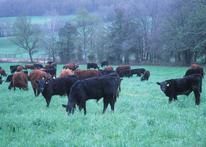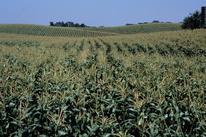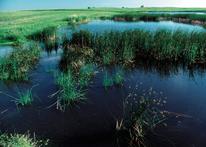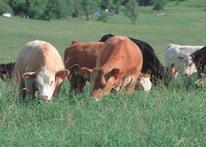By Jill Sackett Eberhart and Constance Carlson
Edited by Kristine Moncada, Craig Sheaffer, Gigi DiGiacomo and Nicole Tautges
The Jones family farm in west central Minnesota was purchased in 1956. The 320 acres were primarily a silty-clay loam with pH ranges of about 7.6 to 8.3. The Jones farm had a dairy operation with supplemental grain crops and forage for the cattle. Over the years, the land and operation passed to the next generation but by the mid-1990s, the family talked about getting out of the dairy business. Matthew Jones, a grandson and prospective heir to the farm, decided to go back to school and left the family farm. His parents continued to farm for some years, but as their retirement age drew nearer, they decided to rent the land to a neighboring farmer.
Off the farm, Matthew received a college degree in Agronomy, settled in a metropolitan area, and started a career. Most importantly, Matthew met and married Karol. Karol had an advanced degree in agroecology and her career was focused on research. Together they shared a deep respect for sustainable land use and agriculture.
As the years passed and Matthew and Karol started their family, Matthew missed the farm more and more. Both Matthew and Karol were getting tired of living in a metropolitan area and they were drawn to the idea of raising their growing kids in a rural, small town setting. In the late 2000s, they decided to pull up stakes and move back to Matthew’s hometown area.
When Matthew’s parents decided to retire and move to town a few years later, Matthew and Karol bought the farmstead and land. The house became their home and they continued to rent the land to a neighboring farmer who farmed corn and soybean using conventional practices. They both continued their careers, the kids attended the local school, and they all became involved in the community.
It wasn’t too long, however, before Matthew and Karol began to consider farming for themselves. Inspired by their love of the land and a belief in sustainable agriculture coupled with their educational backgrounds, they began to reconsider how their land was being managed. They had concerns about the quality of the water in their area. Their region of the state was considered the prairie pothole region, and many of the sloughs and lakes were having serious water quality issues or disappearing completely.
Also, Matthew and Karol were concerned about the quality of their own land after years of conventional row crop production. Inspection of their land showed there were areas with poor water infiltration and patches of herbicide-resistant lambsquarters. Furthermore, Karol and Matthew wanted a safe zone free from the synthetic pesticides used by conventional farmers in which to raise their children.
Many discussions, questions and brainstorming sessions ensued between Matthew and Karol. They debated whether they should they start requiring the land renter to use more sustainable farming practices, or whether they should farm the land themselves so they could control exactly how the land was managed. Karol was especially interested in converting their acreage to organic farming. Matthew had experience working with cattle; maybe a livestock operation would be a good option?
The Joneses voraciously collected information about alternative farming options, the different programs that the United States Department of Agriculture (USDA) had to offer, and what was already being done in their area and around the state. They studied their options, analyzed their personal experiences and goals, and decided their first step would be to establish a livestock grazing system on a portion of their land. They applied for a program that would allow restoration of a wetland in a notoriously wet area near the farmstead and establish roughly 80 acres of pasture for the livestock. The remainder of their farm would still be rented to their neighbor.
Within two years, the Jones family established a small herd of grass-fed finishing beef on their new pasture. It wasn’t long before they saw improvements in the quality of their pasture, water infiltration and an increased presence of wildlife.
Grass-Fed vs. Organic
Matthew and Karol managed their pasture for the first two years without synthetic inputs. If they maintained those same practices for another year, they would be able to certify both their pasture and the livestock as organic in another year. Having an organic livestock operation would demonstrate their commitment to preserving and improving the soil, water and air of their farm. It would also ensure that their children would be exposed to fewer chemicals and pesticides.
However, Matthew and Karol had concerns about whether it was worth the expense and paperwork to obtain organic certification. Organic certification required an application fee (about $300), annual inspections, annual certification fees (approximately $700), and meticulous tracking of forage, feeding and vaccinations. Both Matthew and Karol were working full-time off the farm. The steady income helped to pay household bills and gave them flexibility to take some risks with their farming decisions. But, they were concerned they wouldn’t have time to keep the records required for organic certification.
To sell their beef as certified-organic, Matthew and Karol would be required to have their livestock processed at a certified-organic meat processor. The closest organic processor to Matthew and Karol was at least an hour drive one way. The distance would make it time-consuming and expensive to deliver their cattle for processing and then return to pick up the processed meat. Matthew and Karol were already processing and marketing their cattle locally as grass-fed and their customers were willing to pay a small premium. The difference between the market prices for grass-fed beef versus organic beef was small, and there were organic certification feeds that would need to be covered. Would those same customers be willing to pay a little more for organic grass-fed beef? Or, perhaps Matthew and Karol would find new customers for their beef if it were certified organic.
Both organic and grass-fed beef must have their cattle on pasture to be considered grass-fed, organic or even both. But, unlike 100% grass-fed beef, certified organic cattle can be fed grains when necessary, which would allow their operation some flexibility. However, under certified organic rules, both the grains and the hay must be 100% organic. Because organic hay could be difficult to source consistently, Matthew and Karol assumed they would need to use some of the currently rented acres to establish hay ground. But, those acres had synthetic fertilizers and pesticides used on them, so they would have to go through the three-year transition period to get certified as organic.
An additional concern for Matthew was black fly pressure on the cattle. He was not confident he could manage this pest using only organic methods. Black flies are biting parasites that negatively impact animal weight gain and welfare. They cause animal discomfort by producing skin irritation and blood loss, which can affect livestock health, production and profitability. Because of his experience raising cattle, Matthew knew black flies were a significant challenge.
Conventional and grass-fed beef allow the use of synthetic pesticides and insecticides to keep fly populations in control by spraying the breeding grounds and treating the animal directly. These options are not available in an organic operation, which relies on chemical-free practices that include trapping with sticky traps, using natural predators such as wasps and bats, and composting manure. Matthew’s experience and conversations with other producers indicated that the organic methods weren’t as effective as he would like.
After seeing the improvements that the grass-fed, pastured livestock had already made on their land for soil and water quality and wildlife diversity, Matthew and Karol knew they wanted their farm plans to continue to incorporate sustainable land practices, but how far should they go? They knew the organic certification for their livestock would continue to ensure a safe environment for their children, as well as protect the water and soil. However, Matthew and Karol were seeing a financial return on investment with their grass-fed beef; would the value of certifying their livestock as organic be worth the investment?
* While these cases describe actual situations, names have been changed to protect the identity of participants.
Access the complete decision case study with all educational materials (pdf) >>>
You may cite this publication as:
Eberhart, J. and C. Carlson. 2017. Should We Transition Our Livestock to Organic? A Decision Case Study in Principles for Transitioning to Organic Farming: e-Learning Materials and Decision Case Studies for Educators. K. Moncada, C. Sheaffer, G. DiGiacomo, and N. Tautges (Eds).University of Minnesota, St. Paul, MN.



